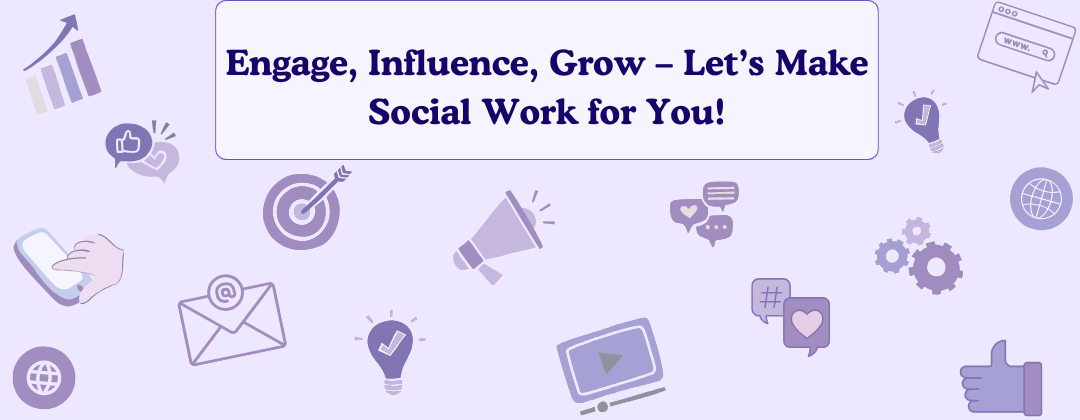Building Brands with Social Power
What is Social Media Marketing (SMM)?
Social media marketing involves creating content for platforms like Facebook, Instagram, and Twitter to promote your products or services, engage with your target audience, and drive traffic to your business.
By creating content that resonates with your followers, you can boost your visibility, attract new customers, and strengthen relationships with existing ones. It’s a fast-changing space with new tools and trends emerging, but the goal remains the same—connecting with people in meaningful ways and driving growth for your business.

Building Brands with Social Power


Building social connections is the foundation for driving real growth in today’s digital age. By fostering authentic relationships, whether through social media, networking, or community engagement, businesses can tap into a powerful resource: trust. Genuine connections lead to loyal customers, organic brand advocates, and long-term success. It’s not just about numbers; it’s about nurturing a network that drives sustainable growth through shared values and mutual support. When people feel connected to a brand or community, they are more likely to engage, recommend, and contribute to its success, creating a chain effect that expands opportunities and drives real, measurable results. In this way, building social connections becomes more than a marketing strategy—it’s the key to unlocking true business growth.
Digimoodit will help you in fostering social connections, so that your businesses can achieve more than just greater visibility—they can cultivate a loyal, engaged customer base that fuels long-term, sustainable growth.
Benefits of Social Media Mraketing

Social media marketing (SMM) is a powerful tool that businesses can use to reach and engage their target audiences, increase brand awareness, and drive conversions. It increases brand awareness by exposing your business to millions of users on platforms like Facebook, Instagram, and Twitter. It also fosters direct engagement with customers, creating a personal connection that builds trust and loyalty.
Here are the detailed benefits of social media marketing:
1. Increased Brand Awareness
~Reach a Larger Audience: Social media platforms like Facebook, Instagram, Twitter, and LinkedIn have billions of active users worldwide. SMM allows you to expose your brand to a vast audience that would be hard to reach through traditional marketing.
~Brand Recognition: Posting regularly helps potential customers recognize your brand. Consistent branding across posts and interactions can make your brand more recognizable over time.
2. Improved Customer Engagement
~Direct Communication: Social media facilitates direct communication between brands and customers. You can engage with your audience in real-time, answering questions, addressing concerns, and building relationships through comments, messages, or live chats.
~User-Generated Content (UGC): Social platforms encourage customers to share experiences, reviews, or creative content related to your brand. This creates a community around your business and fosters engagement.
3. Cost-Effective Advertising
~Affordable Paid Advertising: Social media ads are generally more affordable than traditional advertising methods like TV, radio, or print. You can set your budget, and platforms like Facebook and Instagram offer various ad types with highly targeted audience options.
~Organic Reach: While paid ads are effective, you can also promote your business organically by posting engaging content, using hashtags, collaborating with influencers, or leveraging viral trends.
4. Targeted Marketing
~Precise Audience Targeting: Social media platforms allow you to target ads and content based on specific demographics, interests, behavior, and location. This means your marketing efforts are more likely to reach people who are interested in your products or services.
~Retargeting: Social platforms allow you to retarget users who have previously interacted with your website, increasing the likelihood of conversions.
5. Increased Sales and Conversion Rates
~Direct Sales Opportunities: Platforms like Instagram and Facebook now offer integrated shopping features that allow users to purchase products directly through the app. By reducing the number of steps to conversion, businesses can increase sales.
~Influencer Marketing: Collaborating with influencers or brand ambassadors can further enhance your sales efforts. Influencers have a loyal following that trusts their recommendations, which can boost sales and conversions.
6. Enhanced Customer Loyalty and Retention
~Building Trust: Regular, authentic interactions on social media help businesses build trust with their audience. By sharing valuable content and providing responsive customer service, brands can foster loyalty.
~Customer Support: Social media acts as an additional customer service channel where users can ask questions, report issues, or get help with products. Quick responses help retain customers and improve their overall satisfaction.
Key Social Media Marketing Strategies

Implementing effective social media marketing strategies is essential for businesses looking to enhance their online presence, engage with their audience, and drive conversions. Staying current with trends, encouraging user-generated content, running contests, and leveraging social listening tools can enhance your social media presence and effectiveness.
Here’s a detailed look at key strategies for social media marketing:
1. Define Your Goals
~Set Clear Objectives: Establish specific, measurable, achievable, relevant, and time-bound (SMART) goals, such as increasing brand awareness, generating leads, boosting website traffic, or improving customer engagement.
~Align with Business Goals: Ensure your social media objectives align with your overall business goals to maximize effectiveness.
2. Know Your Audience
~Audience Research: Conduct thorough research to understand your target audience’s demographics, interests, preferences, and behaviors.
~Create Buyer Personas: Develop detailed buyer personas to tailor your content and messaging to meet the specific needs and pain points of different segments of your audience.
3. Choose the Right Platforms
~Select Relevant Platforms: Identify which social media platforms your target audience uses the most (e.g., Facebook, Instagram, Twitter, LinkedIn) and focus your efforts there.
~Consider Content Type: Different platforms cater to various content types (e.g., visuals for Instagram, professional content for LinkedIn). Choose platforms that align with your content strategy.
4. Create High-Quality Content
~Engaging Visuals: Use high-quality images, videos, infographics, and other visual content to capture attention and encourage sharing.
~Valuable and Relevant: Provide valuable content that resonates with your audience, such as how-to guides, industry news, tips, and entertaining posts.
~Consistency: Maintain a consistent tone, style, and branding across all your social media platforms to strengthen brand recognition.
5. Engage with Your Audience
~Prompt Responses: Respond to comments, messages, and mentions quickly to show that you value your audience’s input and foster a sense of community.
~Encourage Interaction: Use polls, quizzes, questions, and calls-to-action to encourage engagement and interactions with your posts.
6. Utilize Paid Advertising
~Targeted Ads: Use paid advertising on social media platforms to reach specific demographics and increase visibility among your target audience.
~A/B Testing: Experiment with different ad formats, messaging, and visuals to identify what works best for your audience and optimize your ad performance.
7. Leverage Influencer Marketing
~Partner with Influencers: Collaborate with influencers who align with your brand to tap into their audience and credibility.
~Micro-Influencers: Consider working with micro-influencers, who often have highly engaged audiences and can be more cost-effective.
8. Monitor and Analyze Performance
~Track Key Metrics: Use analytics tools to monitor key performance indicators (KPIs) such as engagement rates, reach, impressions, clicks, and conversions.
~Adjust Strategies: Regularly review your performance data to identify what’s working and what isn’t, and adjust your strategies accordingly for continuous improvement.
9. Stay Current with Trends
~Follow Industry Trends: Stay updated on the latest trends and changes in social media algorithms to adapt your strategies accordingly.
~Participate in Relevant Conversations: Engage in trending topics, challenges, and discussions to increase visibility and relevance.
10. Encourage User-Generated Content (UGC)
~Build Community: Encourage your audience to share their experiences with your products or services, which can enhance trust and credibility.
~Share UGC: Highlight user-generated content on your profiles to create a sense of community and encourage others to contribute.
Conclusion
Implementing these key social media marketing strategies can significantly enhance your brand’s online presence, foster customer relationships, and drive business growth. By setting clear goals, understanding your audience, and continuously analyzing and adapting your strategies, you can leverage social media to achieve your marketing objectives effectively.
